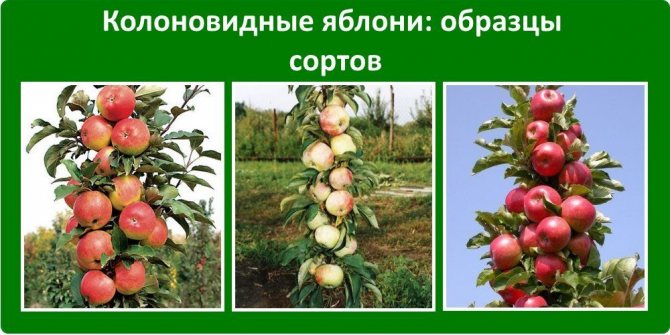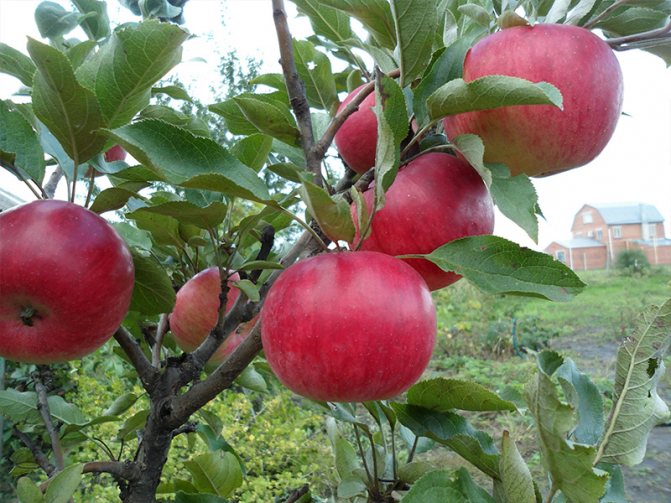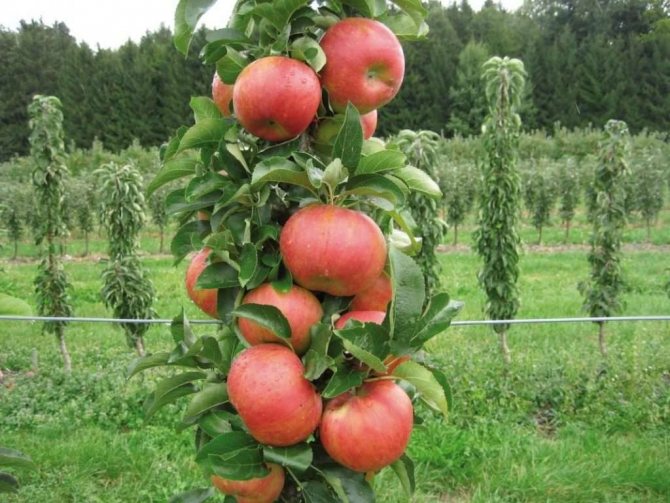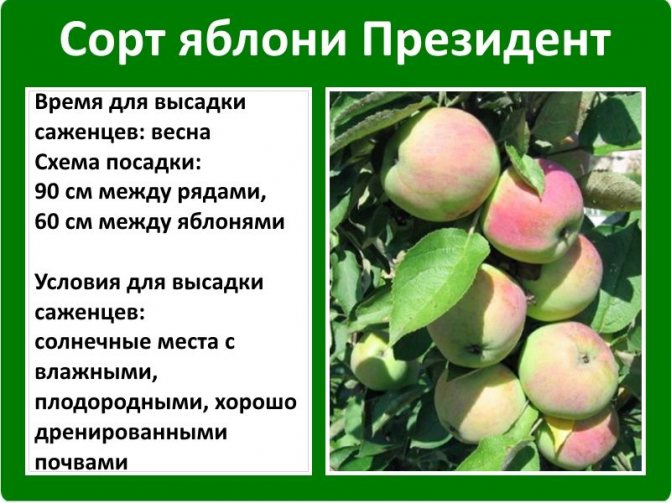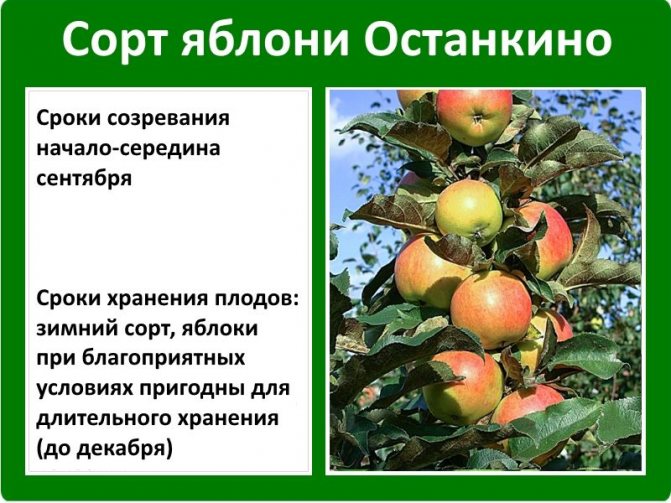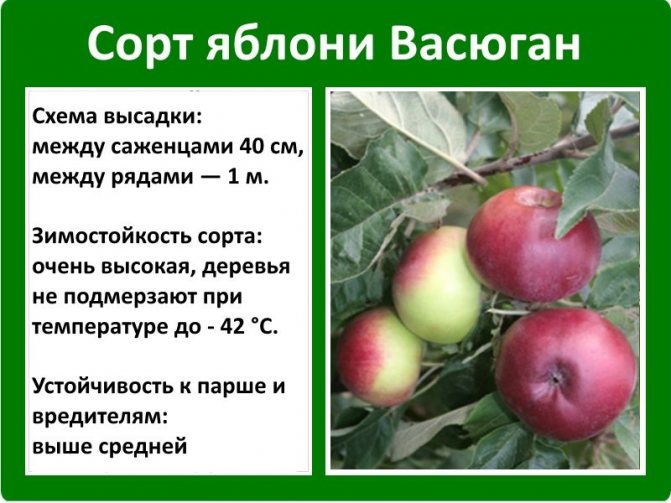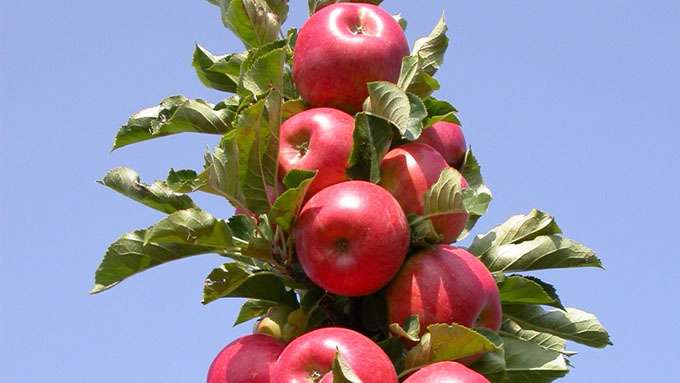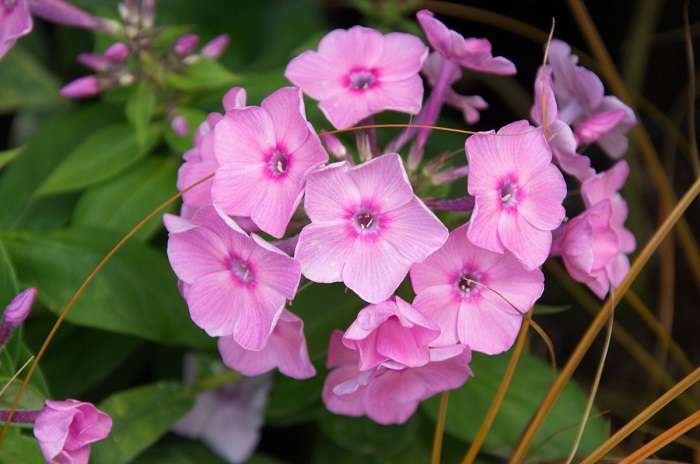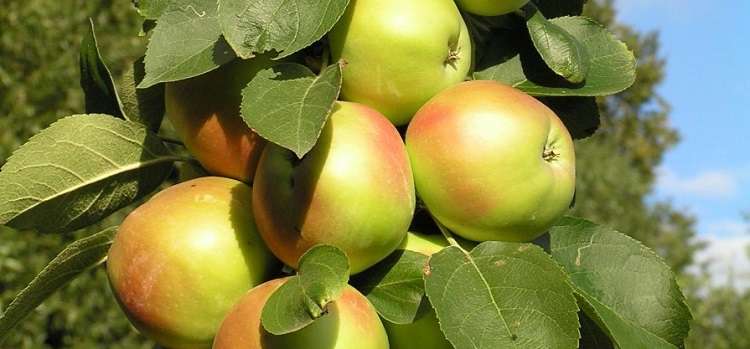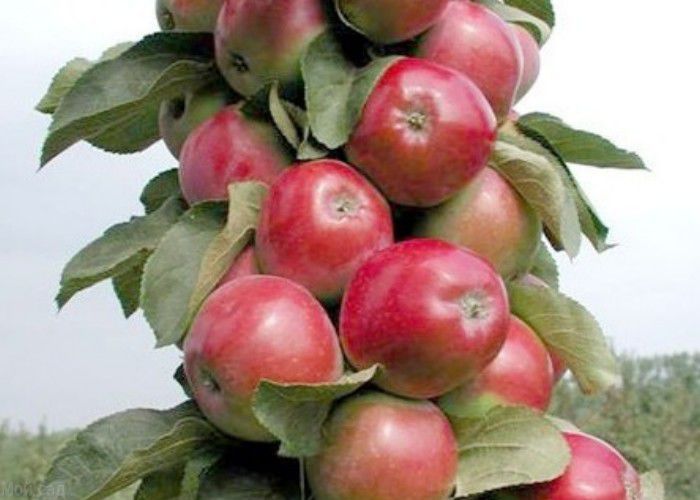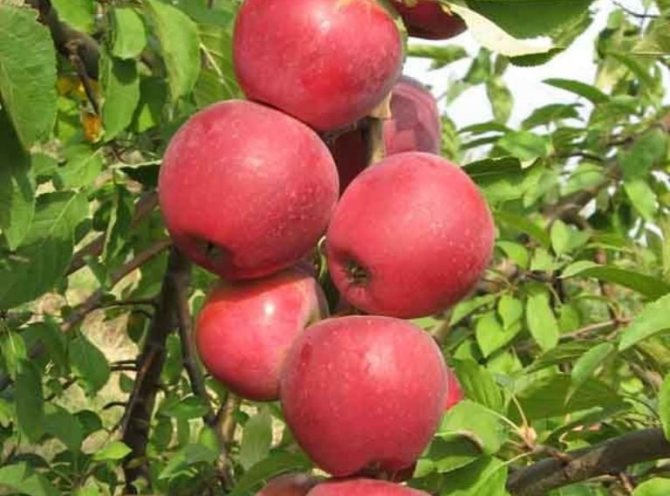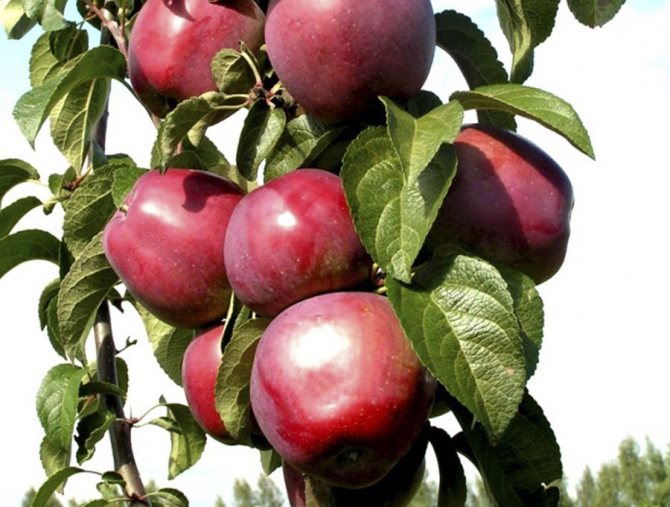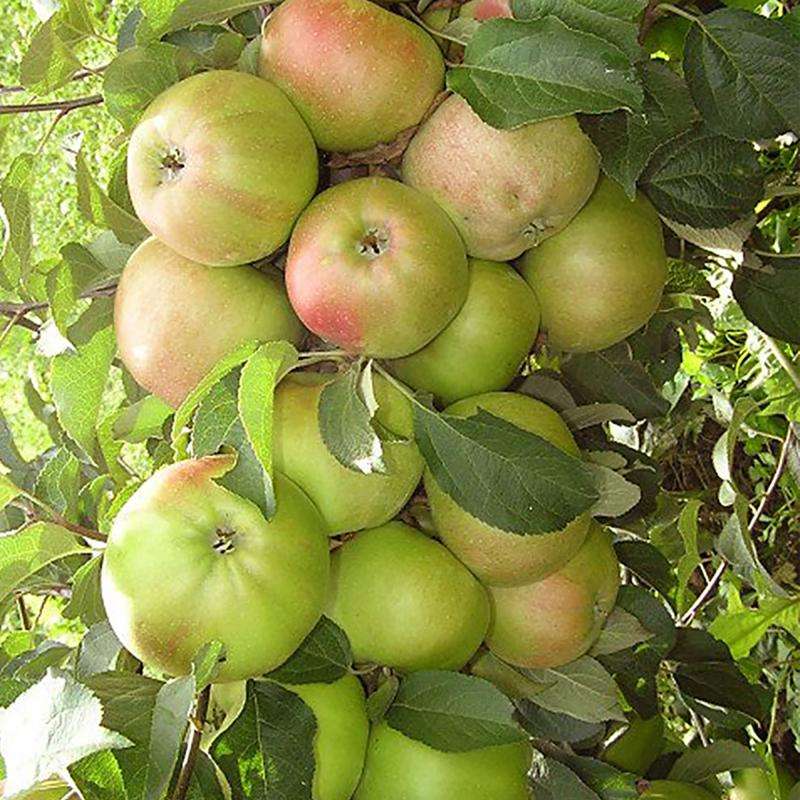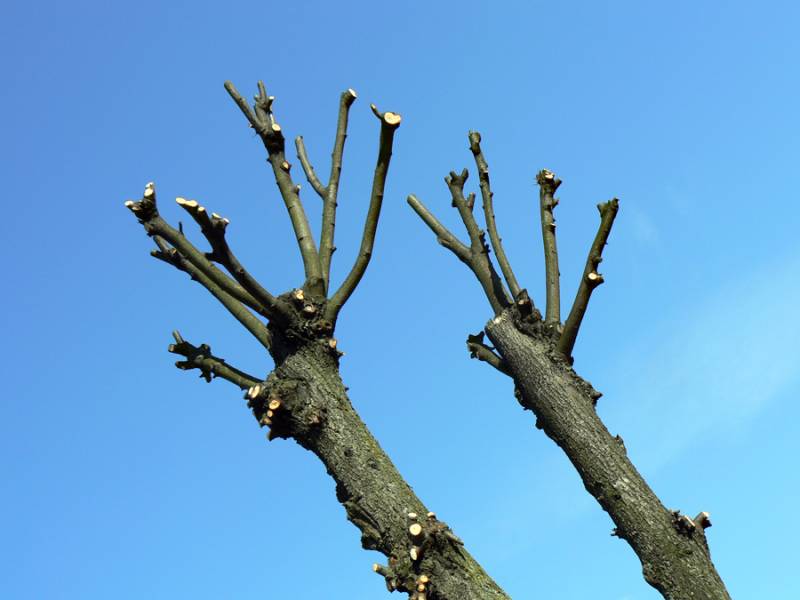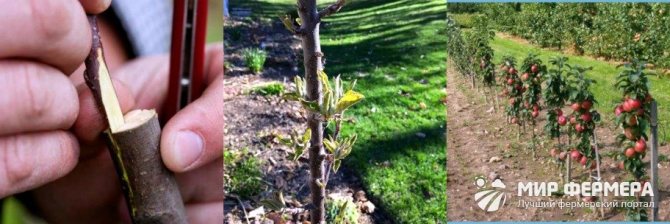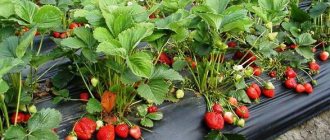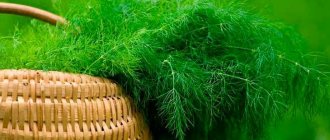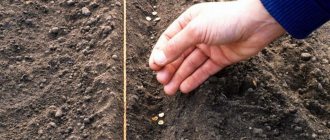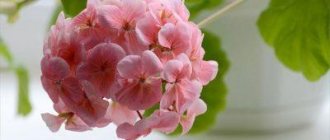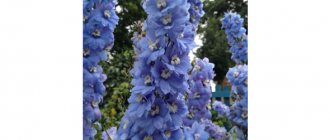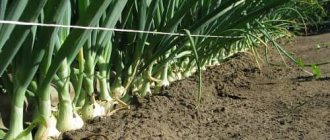The columnar tree species, which appeared in the 60s of the last century as a result of a mutation of the common apple tree, quickly gained popularity among gardeners. The absence of a spreading crown allows them to be used for small areas, while getting good yields. However, caring for them requires special attention. The correct planting of the columnar apple tree in spring and autumn is especially important.
Today there are about a hundred varieties of columnar apple trees, differing in size, taste, degree of hardiness in relation to a variety of climatic conditions. But how to plant a columnar apple tree?
How to plant columnar apple trees correctly. Planting seedlings of a columnar apple tree
For planting, it is more practical to use annual seedlings. They take root faster, although they look very small and thin outwardly compared to biennials. Planting is best done in the spring before bud break. Drainage is carried out from coarse gravel and sand with a layer of at least 20-25 cm. The removed soil of the planting pit must be mixed with humus or mature compost and mineral phosphorus-potassium fats. For one tree, the mixture should contain 4-5 kg of organic matter and 80-90 g of superphosphate and potassium sulfate each. Add a glass of wood ash to the mixture and mix thoroughly.
We set the trunk of the seedling in the hole strictly vertically, straighten the roots, drive in the support. The root system should be freely located in the hole without bending the roots. We start filling from empty places, moving towards the seedling. Given the fragility of the vaccine, be careful and careful. After filling the hole to the middle, lightly tamp the soil and pour 0.5 buckets of water not cold from the street, but better at room temperature. After absorbing, check the position of the graft in relation to the edge of the planting pit. The graft should rise 2-3 cm above the ground. If the graft is dug in, the roots of the scion may begin to develop under unfavorable conditions. Finally, we fill the hole, compact the soil around the stem and tie the seedling to the support with a wide tape through the figure eight. We form a hole with sides no higher than 2-3 cm around the trunk of the seedling and add water. For each seedling, water consumption is 1-2 buckets, depending on the age of the seedling. After planting, the soil is mulched. Mulch is removed for the winter.
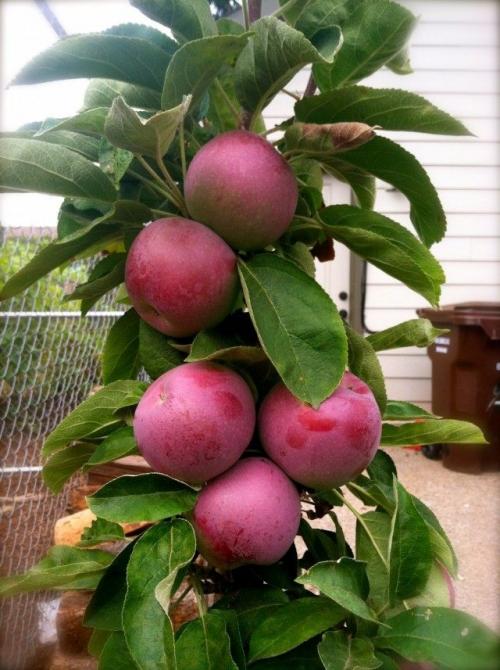
Reproduction
There are three methods of breeding colonovids:
- by grafting a varietal cutting onto a suitable stock;
- seeds;
- air layering.
The first method requires experience and is suitable primarily for professionals. The propagation of hybrids by seeds is extremely unreliable: they most often do not retain the properties of the mother plant, the results will become clear only after 2-4 years.
The method of air layering is laborious, and the probability of success even with experienced gardeners is only 50%.
For those who have not previously been involved in the reproduction of apple trees, buying seedlings in nurseries, despite the costs, is the best option.
Columnar apple tree Cheburashka. Description of columnar varieties of apple trees
Columnar apple trees are good for their compactness. Even in a small area, you can plant a couple of dozen seedlings, or even more! In addition, they begin to bear apples as early as the second summer or autumn after planting, reaching the peak of fruiting in about the fifth year. Many wonderful varieties are suitable for the Russian climate.


"Letniki"
Summer apple varieties begin to ripen in the middle lane in July or August. Brief descriptions of the most popular columnar "letniks":
- "The president". Yellow-green apples with a slight pink blush are harvested in late August or early September and can be stored until the beginning of winter.The fruits are juicy, taste sweet and sour, an average of 180 g each. The apple tree reaches 3 m in height, yields 5-7 kg of harvest per year. A huge "plus" - "President" will not freeze even in frosts up to 40 degrees.
- "Nectar". The tree grows up to 2.5 m. At the end of summer, it brings about 10 kg of large apples (250 g each) of golden color. A distinctive feature is an extraordinary "honey" taste. The plant tolerates winter cold well.
- "Scarlet Sails". Late summer variety. Cream-colored apples have a bright scarlet blush, are very tasty and fragrant. The tree grows up to 2 m. But the resistance to diseases and frost resistance of the variety is at an average level.
- "Arbat" is a late summer variety with a high yield - up to 20 kg per tree. Apples are medium-sized, sweet and sour, bright cherry color. They can be stored until December. Winter hardiness is good, but in severe frosts, the top can freeze, so it is better to cover the tree.
- "Dialogue" is an early variety, yellow apples of which have been eaten since the beginning of August. The pulp is dense and juicy, slightly sour. The variety is winter-hardy.
Other notable varieties of summer columnar apple trees: "Chervonets", "Luch", "Iksha", "Cheburashka".
"Autumnists"
Characteristics of several varieties, whose apples ripen in autumn:
- "Vasyugan" (the variety is sometimes referred to as late summer). According to gardeners, it winters better than Antonovka! It begins to bloom and bear fruit in the first year after planting, but it is better to break off the flowers or ovary. Apples at "Vasyugan" are elegant, red-yellow, sweet and sour taste, with dense pulp. As a dessert, fruits are not to everyone's liking, but for jam, compotes and jams, this is a great option.
- "Maluha" is so named because the apple tree of this variety does not grow taller than 1.8 m. And its yellow-green fruits are famous for their wonderful dessert taste and aroma. The variety is winter-hardy and resistant to many diseases.
- "Senator" - a variety with very large (up to 300 g) apples, with soft and juicy sweet pulp, which are stored until January. But, unfortunately, the “Senator” cannot withstand forty-degree frosts.
- "Garland". A very productive variety. Immune to scab. Apples are yellow-green with a reddish barrel, sweet and sour.
- "Garnet bracelet". An unusually beautiful variety that can be grown as an ornamental one. The low trunk with dark dense leaves is strewn with “pomegranate” apples in autumn. The taste of the fruit is inferior to most varieties, but excellent for processing.
Also among the Russian summer residents are in demand for "osenniks" "Dekabrenok", "Talisman", "Yesenia" and other varieties.
"Winter roads"
Apples of "winter" varieties are harvested unripe in October. By November, the fruits ripen, and then lie well throughout the winter.
- "Currency". The rosy red-green apples of this variety are picked in early October. The fruits can lie all winter. The weight of each is 200 g, the taste is sweet.
- "Amber Necklace". This variety is distinguished by its high yield - 15 kg (or even more) apples per year! Fruits up to 180 g, golden with a blush, sweet taste. The tree winters well.
- "Moscow necklace". One of the most frost-resistant varieties. The apples are medium in size, red, sweet and sour. The variety requires planting an apple pollinator. In addition, part of the ovary should be cut off during and immediately after flowering.
- Ostankino. A very elegant columnar apple tree: in the fall, shiny red apples cover the trunk almost from the ground. The taste is sweet and sour, pleasant. The fruits can be stored until December. The variety's resistance to disease and winter cold is high.
- "Idol". The yield of the variety is not the greatest, but the taste of apples is wonderful. The fruits are large, with a dark pink blush, good both fresh and for canning. The tree is quite unpretentious and survives the winter well.
- "Gin". The variety is resistant to scab and other diseases. It tolerates frosts down to -45 degrees - such apple trees can be planted even in the Urals and Siberia. Gin's apples are bright red, with a pleasant sweet and sour taste.After harvesting, the crop is stored for up to six months.
Other popular late-ripening varieties: "Delight", "Priokskoye", "Snow White".
Seeds
Usually seeded apple trees in private gardening are not propagated... This method is used in nurseries to obtain new varieties (hybrid forms).
And on a personal plot, an apple tree obtained from a seed will always be wildbecause it does not often inherit the characteristics of the mother plant. This is just seed stock for a tree of the desired variety, which starts bear fruit only for 6-9 years.
- Quite tall;
- Unpretentious;
- The most productive.
To obtain seeds, pollen from flowers of one variety is transferred to pollen from flowers of another variety. The seeds obtained in this way carry the properties of both parents.
Unfortunately, not all desirable properties of an adult plant are preserved. The process is laborious, requires repeated attempts, and is available mainly to experienced breeders.
Planting columnar apple trees video. Columnar apple tree: how to plant and prune
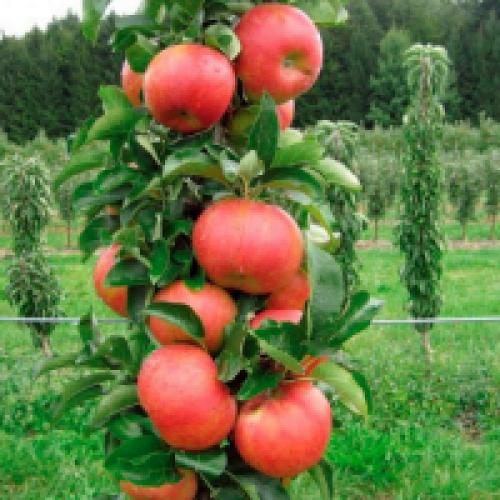

The columnar apple tree differs from the usual one in its appearance. In fact, it is just a long trunk, covered with leaves and fruits, but completely devoid of side branches. It is interesting that this variety is not a hybrid, since it was formed by a natural mutation, which was later propagated by breeders.
In today's article, we will consider not only the varietal characteristics of columnar apple trees, but also provide detailed instructions for planting and caring for this crop.
What features does a columnar apple tree have?
If you look at the columnar varieties of the apple tree, you will immediately notice its differences from the usual one. Habitual garden trees have a main trunk, from which side branches with fruits extend. Columnar apple trees do not have these branches, and the fruits are formed and ripen right on the trunk (Figure 1).
Note: The first such apple tree was discovered in 1964 in Canada. In the process of natural mutation, a branch without shoots was formed on one of the trees, on which completely full-fledged fruits were formed. Scientists noticed and propagated this culture, and now everyone can grow an unusual columnar apple tree on their site.
The external characteristics of such trees make it possible to compare them with pyramidal poplars. Apple trees have a main conductor, and a few branches branch off from it at a very acute angle. Thanks to this, the shoots grow almost parallel to the main trunk. In this case, the main shoot is very thick, and small shoots with flower and fruit buds are already formed on it.


The main advantage of this variety is that the trees take up a minimum of space in the garden, but at the same time they regularly bear fruit, and ripe apples are quite heavy.
Among other features of columnar apple trees, it is worth highlighting:
- Most varieties are low, as the trunk height rarely exceeds 3-5 meters. At the same time, the yield of columnar apple trees is absolutely independent of the height of the trunk.
- Almost all crops of this type do not tolerate cold. If the apical bud has been damaged, not only the appearance of the culture will change, but also the sweet taste of the fruit, therefore, such crops must be covered for the winter.
- Young trees begin to bear fruit as early as the second year after planting and are distinguished by a very high yield.
The roots of the plant are very close to the surface, so any manipulations on the trunk circle should be done very carefully. Otherwise, columnar apple trees, like ordinary varieties, are divided into early, mid-ripening and late ones.
Planting rules for seedlings
Planting of seedlings of a columnar apple tree can be carried out both in spring and in autumn, but, given the low frost resistance of this culture, the procedure is best done in the spring (Figure 2).
Note: Disembarkation must be completed before budding begins. Then the seedling will take root well in a new place and quickly start growing.
To grow a productive tree, you need to choose the right planting material. Unlike other crops, which are usually planted with 2-year-old seedlings, the columnar apple tree is best planted with annual plants. They take root much faster and begin to bloom and bear fruit earlier.
When buying planting material, be sure to pay attention to its root system. It should not be dry or rotten. In general, it is better to buy plants with a closed root system in general. The agricultural technology of growing them is much simpler, and planting can be carried out at any time of the year, except for winter.


Diseases and pests
Despite the fact that the columnar apple tree is considered a resistant plant, many insects love it: aphid, glass, leafworm, scoop, moth. Special insecticides will help get rid of pests. Preventive measures will help prevent the development of insects: spring and autumn spraying, timely removal of weeds, whitewashing of trunks, loosening the soil.
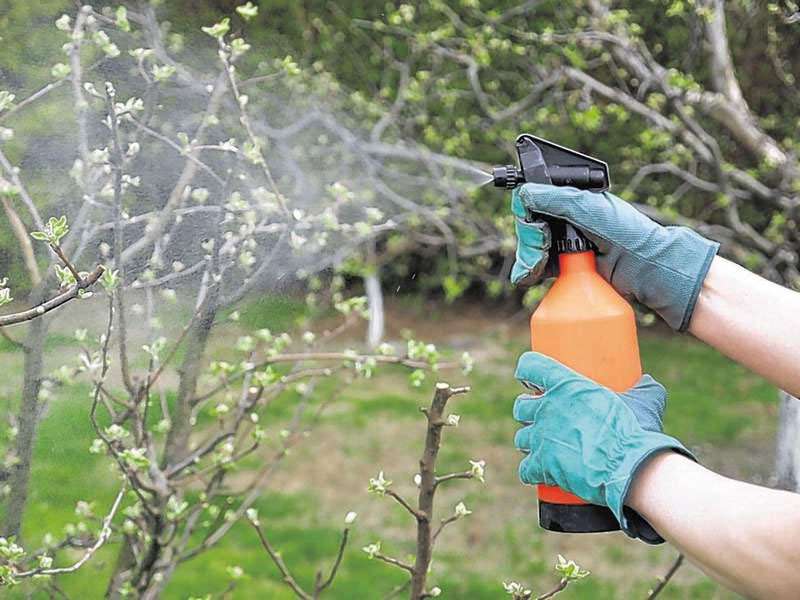

Dangerous for plants and infections, especially fungal diseases. Fungicides are used to treat ailments. It is noteworthy that a significant spread of the disease can lead to the death of an entire garden. For prevention, preventive measures are used, similar to pest prevention.
Columnar apple trees reviews. Baby
Very often in nurseries they ask for this autumn variety of columnar apple trees of Russian selection:
- That is why they called it that. Because of the height of the tree. From the nature of a bonsai;
- Already in the first year of spring planting, the most impatient can taste the first apples. From the age of 4, they bring full-fledged harvests;
- These are apples of almost the same size, greenish-yellow with a pink tint;
- You can take your time to consume or process apples harvested in September. They can wait a couple of months. Almost until December;
- And in taste, it competes with the most delicious ordinary apples. Sweet and sour juicy pulp. The aroma is also felt. They are even called dessert;
- Resistance to disease and frost allows us to consider it a zoned variety for central Russia. Not to mention the more southerly places. But you need to prepare for the winter in full.
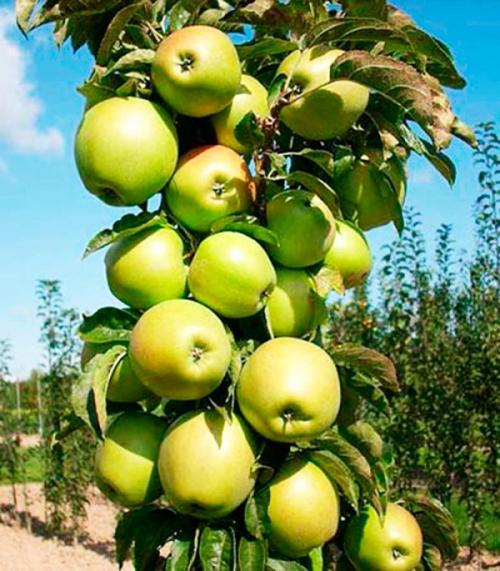

Baby.
You can read more about Malukha's apple tree here.
Reviews about Maluha:


Yaroslav. “I have never met apples tastier among columnar apples. Maybe for now.
Real dessert taste. Very juicy. If you try it once, you will never forget the taste. It's like the taste of Antonovka and White filling inimitable.
And a very pleasant yellowish flesh color. My friends are also delighted with them. They are already looking for seedlings of this variety in nurseries.
Fruit tree yield
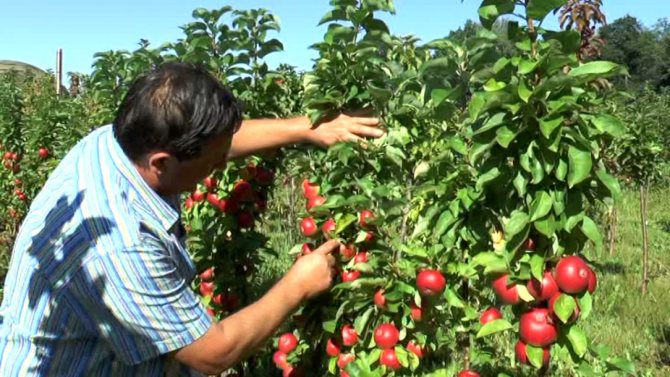

In general, any columnar tree bears fruit well. The apple tree is no exception, it even leads to slight difficulties. Due to the fact that the ovary appears a lot, you can not wait for a full harvest. It is recommended to thin it out for several years in a row, if the tree has not yet matured enough during this time.
In the first year, all the ovaries must be removed, the next leave five, and the third already ten. While the tree is blooming, half of the bouquets are removed, when the ovary has appeared - another half, when it reaches the size of cherries, only the two most beautiful ones are left, and one must grow to the size of a walnut. In subsequent years, up to 12 kg of apples can be obtained from one tree, but only with appropriate care.
Varieties of columnar apple trees.
Review of the best varieties of columnar apple trees - according to gardeners' reviews
Even 10 years ago, the idea of growing a columnar apple tree in the conditions of the Middle Belt was called dubious.Now in the gardens there are good adapted varieties of columnar apple trees. Gardeners have been able to find a special approach to grooming and shaping that differs from the southern experience. We present to you a description of the best varieties of columnar apple trees - according to reviews of experienced gardeners.
As before, the highest risk of growing columnar apple trees is associated with insufficient winter hardiness of the form and freezing of flower buds. In the Central region, annual freezing of the apical bud is considered the norm, which leads to the appearance of several competing shoots. The shaping strives to always leave only one main trunk.
The growth vigor of columnar varieties depends on the rootstock. In the south, grafting is done on a dwarf stock, but in the northern regions, practitioners prefer vigorous ones, on which the columns grow up to 3 m high.
What explains the popularity of columnar apple trees? Trees are compact, decorative during flowering and fruiting (flowers densely cover only the trunk), not shading nearby plantings. A dense planting scheme allows you to expand the assortment in taste, color and ripening time. Saplings on a dwarf rootstock bear fruit in the 1st year after planting, on a vigorous one - on the 3rd - 4th, which is also considered early fruiting.
The negative sides of the columnar apple are fragility (after 10 - 15 years it is better to replace the trees) and the complexity of pollination (you need to plant a collection of several varieties). The root system of the columns is shallow, so there is a high risk of damage by rodents. Vole attacks are dangerous even for an adult tree. This must be taken into account when preparing plantings for winter.
History of appearance
These unusual plants appeared by accidental hybridization in the middle of the last century in Canada. The gardener noticed a branch on his ordinary Macintosh apple tree, on which there were almost no side shoots, but many fruits grew. Then he took some cuttings and grafted them onto the rootstocks. The mutation proved to be resistant, so it soon became a separate species. Columnar apple trees began to be actively cultivated in the 80s., a little later, other trees of this species appeared: pears, plums, cherries, etc.
This plant looks like this: a trunk grows from the roots, but instead of branches, there are fruits, ringlets and spears on it, on which flowers develop. The tree reaches a height of 2.5-3 m, in width with proper pruning - no more than half a meter.
It bears fruit for about 15 years, and can live up to fifty.
Planting a columnar cherry. How to plant
Planting columnar cherries on the site has certain features and is somewhat different from a similar procedure for conventional varieties.


Selection and preparation of seedlings
The first thing to look for when choosing a columnar cherry seedling is the apical bud. If it is damaged, then the tree will not grow upwards, and the harvest from it may never be obtained. The root system of the plant must be well developed, free from signs of fungal and other diseases. Mechanical damage is not allowed on the seedling.
Seat selection
A well-lit place, protected from strong gusts of wind and drafts, is suitable for planting cherries. The soil on the site is preferable to be loose, rich in nutrients. It is impossible to plant trees in lowlands and in places with close occurrence of groundwater.
How to prepare a site
On the site where the planting of cherries is planned, all weeds are removed in advance, the soil is dug up and fertilizers are applied. If the planting is planned for the spring, then it is better to fill the garden in the fall. To do this, they bring in not only organic matter, but also superphosphate, which, by the time of the onset of heat, will just have time to decompose and enrich the earth with the necessary microelements.
Arrangement of the landing pit
To plant a columnar cherry, a hole of 70 x 70 cm is dug. A mixture of compost and manure 0.25-0.3 cm thick is placed on the bottom. A 10 cm thick layer of sand is poured on top, and then a layer of organic or multicomponent fertilizers. To protect the roots from waterlogging, you can preliminarily (at the very bottom) lay a drainage layer of broken brick or small pebbles.
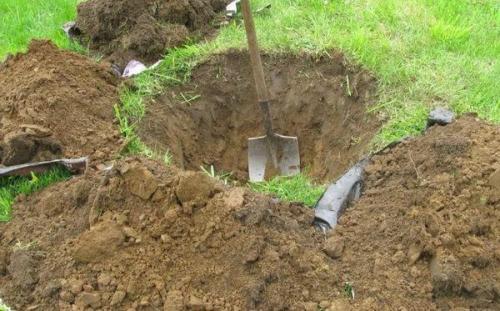

Landing scheme
The seedling is placed in a prepared planting hole, the roots are carefully straightened, a supporting wooden peg is installed and the hole is covered with nutritious soil. After that, the tree is tied to a support and watered abundantly. Pour 20-30 liters of water under each plant.
The distance between the columnar cherries is left at least 2.5 m. Otherwise, they will simply shade each other, interfering with normal development.
Timing recommendations
Both spring and autumn can be chosen as the time for planting cherries on the site. In the Moscow region and in the middle lane, spring planting is preferable, since seedlings often do not have time to take root before the onset of cold weather and freeze out in winter.
Spring planting work is carried out before the start of active sap flow, when the threat of severe night frosts has already passed. As a rule, this time falls in April.
Care
Columnar apple trees require attention and care throughout the growing season. Only in this case good yields are guaranteed.
Features of care at different times of the year:
| Season | rules |
| In the spring | After wintering, broken and damaged shoots are removed. Sanitary pruning is complemented by shaping. This is especially important when side branches are forming. With the beginning of the growing season, apple trees are fed with a full complex of NPK mineral fertilizers (nitrogen, phosphorus, potassium). In order for young plants to develop normally without spending energy on fruiting, all buds are removed from one-year-old seedlings (you can leave 1-2 to evaluate the taste of the fruit). In two-year-olds, about 10 flowers are left for the same purpose. |
| In summer | It is important to regulate the number of ovaries. One apple should ripen on each fruiting branch. This is achieved by regulating their number in stages at the stages of flowering, setting and the beginning of fruit growth. The best way to fight disease is through prevention. Inspections of fruit trees should be regular and thorough. Treatment with insecticides or fungicides in the early stages of the disease is the most effective way to deal with the problem. No chemicals can be used a month before harvest. Nitrogen is excluded from top dressing, starting in August. Conversely, potassium helps prepare the tree for winter, accelerating the ripening of the shoots. |
| In autumn | Time to prepare for winter. After the foliage is dropped, a corrective formative pruning is carried out. The season ends with pre-winter activities. |
Watering
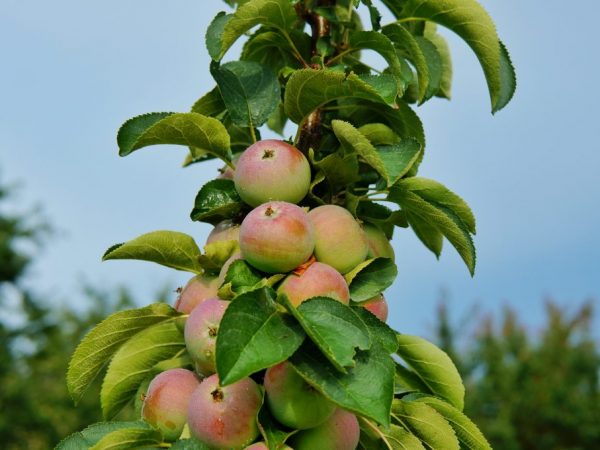

The correct watering affects the development of the plant.
Caring for columnar apple trees is not only about preventing pests and diseases. Proper watering is important, which determines the growth rate of the tree and the quality of the fruit.
Excessive moisture can provoke fungal diseases. Therefore, watered as needed. Frequency and volume depend on weather and soil. After planting, Colonovids should be watered regularly every 3-4 days for the first three weeks.
Further moisturize less often. In hot dry summers, this should be done no more than once a week, but abundantly, 10-15 liters under one tree.
And do not forget about "dry" watering - mulching and destruction of weeds in the near-trunk circle. Straw mulch should be removed for the winter so that it does not attract rodents. Tinning the space around the tree with lawn grass, cereals, green manure helps to preserve moisture.
The best option is continuous drip irrigation of apple trees.
In addition to watering, sprinkling is carried out from the shower two to three times a month, washing the entire aerial part of the plant.
Top dressing
Organic fertilizers, which many are addicted to, are primarily soil improvers.
They are brought in only once when planting (transplanting) an apple tree. The rest of the reserves are best used when digging the beds. An excess of fresh organic matter leads to a decrease in the immunity of the apple tree to fungal diseases.
Mineral fertilizers are a must. Single dose - 20 g (1 matchbox) per 1 sq. m of the trunk circle. During the growing season, they are applied 3 times:
- in the beginning of May;
- in the middle of July;
- in the fall, after harvesting (in this case, you cannot use nitrogen, which stimulates the growth of green shoots, which is unacceptable before wintering).
You need to be especially careful with feeding young (up to 3 years old) apple trees. Initially, it is important to strengthen their root system, therefore, the complex requires more phosphorus and potassium, but less nitrogen. The ideal combination for this would be the NPK ratio of 3-20-20.
The culture is responsive to foliar feeding. They are especially effective if the roots cannot extract enough nutrients from the soil:
- due to the poverty of the soil;
- during drought, when water-soluble micro- and macroelements are not supplied to the root system;
- at low soil temperatures, at which absorption by the roots practically stops.
Apple orchards are sprayed:
- at the beginning of flowering - 1% superphosphate solution;
- after flowering - Bordeaux liquid with the addition of 1 tsp of urea per 1 liter of solution;
- in summer 0.5% urea solution to combat scab;
- in August - 3% solution of simple superphosphate;
- after harvesting - 4–5% urea solution.
Preparing for winter
Fallen leaves, the remains of other vegetation can serve as a shelter for insect pests and fungal spores. All this must be carefully collected and burned. The trunk circles are carefully dug up.
In winter, apple trees, especially young ones, face two dangers: frost and rodents.
The most reliable way to protect the bark from mice and hares is mechanical protection. The trunks of trees that have dropped their foliage are covered and wrapped with roofing material, fiberglass or glass wool, spunbond. Coniferous spruce branches are also traditionally used.
Mice can creep up to an apple tree under the snow. To eliminate this, the first snow in the trunk circle is trampled down when it is wet. After freezing, it will become an insurmountable barrier for mice and will also be a good protection from frost. If there is a lack of snow in winters with little snow, young seedlings can be scooped up from the surrounding areas.
Pruning


Pruning is carried out twice a year.
Columnar varieties of apple trees are capable of self-regulation of their crown. Their pruning is aimed at balancing growth and fruiting, it is very simple: all side shoots longer than 20 cm are cut in the spring to 5-15 cm.
If the columns are grafted on strong vigorous rootstocks that provide active growth of branches, then pruning is carried out 2 times a year: in spring and in July.
The crown kidney is the growth point. You cannot touch it. If it is damaged, it is replaced with a lower-growing shoot.
Lateral branches, when they appear, are cut off at the base of the trunk. Fruits on columnar apple trees grow on ringlets and spears emanating directly from the tree trunk.
So that the fruit load on the tree is not excessive and there is no strong crumbling of the crown, it is recommended to thin out the fruit.
Breeding by layering
Branches of shrubs, only touching the ground, take root and form layers. For trees, everything is somewhat more complicated: fresh shoots need to be bent to the ground and buried... The shoot is associated with the mother plant and forms roots during the summer.
Cultivation of apple trees by layering is done like this - a young plant, already rooted, carefully separated from the mother and planted in a permanent place. Step by step, this process looks like this:
- The green part breaks off from the shoot 20-30 cm from the top;
- We make small indentations where the shoot is in direct contact with the ground;
- We bend it to the surface and fix it;
- We fill the hole with the composition: sand + earth;
- The top must be tied up so that the future tree grows up;
- This year's shoots are used.
Root offspring
By root offspring, the apple tree is propagated relatively seldom... They are used as a stock and graft on them the cultivar you need. Root suckers are harvested from strong, well-bearing trees.
They are used at 1-2 years of age, digging in the autumn-spring period. The best offspring are located at a distant distance from the mother tree.
The method is not universal and has some limitations:
- Small% survival rate;
- Possibility of obtaining insufficiently valuable clones.


Content
- Listen to the article
- Description
- Planting a columnar apple tree When to plant
- Planting in autumn
- How to plant in spring
- Spring care
- When to trim
- How to propagate
Harvest
Harvesting is straightforward, since the height of the columnar apple trees does not require special devices. Harvesting begins according to the grade. The harvested crop immediately after the bulkhead is placed in a storage facility (basement, cellar) in separate small containers, boxes and other containers. For winter storage, the optimum temperature is +2 .. + 3 ° C. Varieties with a short shelf life are used for processing (juices, compotes, jams, etc.).
- Part 1. Columnar apple trees - features and the best varieties
- Part 2. Features of growing columnar apple trees
Basic tips for growing an apple orchard
Regardless of the chosen method of breeding apple trees, you should adhere to some recommendations that will help achieve the best result. To increase the number of fruitful trees and get a high-quality harvest, you should pay attention to the following tips:
- Cultivation of apple trees by cuttings is not performed in the spring, since the cuttings begin to grow actively and draw out nutritious juices from themselves. As a result, the sprouts dry up and do not take root in the ground.
- It is better to prepare cuttings for propagation in the summer, when they are filled with useful trace elements from fertilizers.
- On trees growing for more than 5 years, it is allowed to do several grafts at once. It is recommended to fix the scion at a distance from the trunk.
- Apple trees with grafts must be constantly looked after, fed, watered and eliminated pests. For proper tissue fusion, stable moisture is required even with occasional rains.
Following simple rules will help get rid of problems when breeding trees. Minor nuances of tree reproduction can significantly increase the number of fruits ripening per season.
Air layering
it one of the longest used breeding methods... On the lignified shoot of the apple tree, the process of root formation should go:
- At a distance of 15-30 cm from the top, all leaves are cut off from the shoot;
- On the shoot, the bark ring is removed for treatment with growth stimulants (stimulate root formation);
- Roll a lump of wet moss;
- The lump is divided into two parts and the bare area is properly wrapped;
- It is moistened with stimulants and tightly wrapped with electrical tape or polyethylene;
- After the end of the dormant period, young growth is removed from the cut;
- Gradually, in the area where there is no bark, the process of root formation takes place;
- The shoot is cut from the main branch, the film is removed and planted in a permanent place.
Air layering technology
To breed apple trees without using the grafting procedure, you can use an alternative method. The use of air layers makes it possible to form new roots in the area of tree damage.
The part of a branch capable of fruiting is considered to be a layering. The principle of reproduction is to artificially stimulate root growth. To propagate a tree through an air layer, you need to follow a simple instruction:
- choose a branch with a diameter of 1.5-2 cm with a young green growth;
- wrap the free space on the branch with electrical tape to create a greenhouse effect;
- at the beginning of the summer period, make cuts on the branch and build a container with a stimulating solution around;
- leave the container for a couple of days, then drain the liquid and fill the free container with a moistened substrate;
- at the end of August, cut off a branch with a pruner and transplant into open soil.


